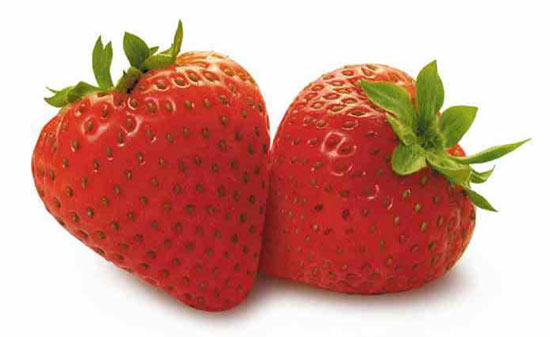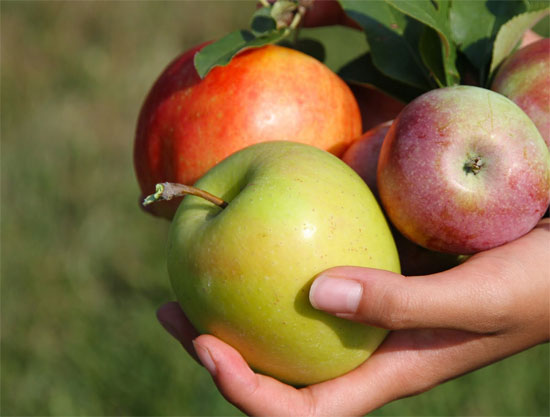How to wash fruits correctly to remove chemicals
Washing fruits properly to ensure food safety is not a simple thing for women and mothers. For different fruits, there are also specific tips for each type.
1. Strawberry

Remove unripe or crushed fruits, dirt and soil. Then put the remaining fruits in the basket, place them in the water basin, wash three times, drain the water. Wash directly under the tap. Use a soft brush to clean the crevices on the surface of the skin. Finally, rinse with cooled boiled water and store in the refrigerator.
The green nipples of strawberries should only be removed when washed , this is a general rule for all fruits of the strawberry family. If you junk them before washing, the water will seep into the fruit, and they are no longer delicious.
Interestingly, Spanish people often wash strawberries with white wine! They believe that, thus, will keep the smell and taste of strawberry.
2. Apples

Apple shells contain a lot of nutrients but are also the places where most of the chemicals are stored during storage. Many people like to eat apples all over their shells because their shells are very crispy.
However, if improperly washed, it will not eliminate all the chemicals on the surface of the shell, and may even be toxic to the body.
First, wash the apple with clean water once to remove any dust and dirt from the crust. After that, rinse the apple shell with salt with diluted hands. The antiseptic in salt will remove the remaining parasites on the pods.
Pay attention to thoroughly rinse the knob because it is the place where most bacteria and chemicals are concentrated. Finally, rinse with cold water and drain. At that time, you can be assured of the apple's hygiene.
3. Grapes

The grape surface has a very thin membrane. This coat is a "shield " to protect the fragile crust and bring freshness and beautiful shine to the fruit, but it is also a place to " attract " dust and bacteria outside the environment.
Therefore, in the washing process, it is necessary to be very careful to ensure the cleanness of the germs and ensure the freshness of this fruit.
Wash the grapes under the tap , softly wipe your hands or cotton around the fruit to remove dust and germs. Do not put grapes in pots and strong. Doing so will cause the grape to crush and lose its freshness.
The luxuriant beams should use a knife to divide, rather than pulling the fruit off the stem. After that, rinse under cold running water, put in a basket for dryness.
4. Fruits belong to orange and lemon families

Fruits such as lemons, oranges, tangerines . of the orange family should be rinsed through boiling water first to avoid preservatives on the surface, then rinse under cold water.
5. Types of melons

Melons are both sweet and fragrant. You should wash under cold water by hand or with a brush.
Note : To reduce the amount of vitamins, it is necessary to wash fruits quickly. After washing, they lose the ability to hold on for a long time because the outer shell is damaged. Therefore, the fruit after washing should not be left for long. In order not to lose the tonic, when peeling, use a stainless steel knife.
Chemical methods for detoxifying fruits and vegetables

- Take a potion of potassium perinanganate mixed in a pot of clean water to make the water pink and soak the fruit in that solution for 10-15 minutes, then take it out and wash it again with clean water, let the boiled water be as cool as possible. can eat.
- Or give oxycil solution in the ratio of 0.1 - 0.2ml into 1 liter of clean water and soak the fruit in this solution for 2-5 minutes.This type of solution is non-toxic, non-irritating, has no strange smell and is good at sterilizing.
- However, if you do not have the above solutions, you can wash them and soak them in dilute salt water.If it is a clean fruit (not preserved or incubated with chemicals), it is only necessary to wash it with clean water.
- Tell you 4 best ways to remove pesticides, toxic chemicals on vegetables
- Soaking vegetables in salt water does not remove chemicals but you should still do it
- The naked eye cannot distinguish between fruits with chemicals
- Washing vegetables with clean water is not safe enough?
- How to wash clean parasitic vegetables and chemicals
- The unknown truth about shampoo
- What size of poisonous fruit ripening chemicals?
- Notes to keep fruits and vegetables the most nutritious
- Do you know how to wash pesticides outside the apple shell according to scientific standards?
- Simple way to identify Chinese vegetables and fruits
- A warning for those who do not wash new clothes before wearing
- Experiments show that you are washing your hands extremely 'dirty'
 Soaking vegetables in salt water does not remove chemicals but you should still do it
Soaking vegetables in salt water does not remove chemicals but you should still do it You should limit bamboo shoots if you have 1 in 5 of these diseases
You should limit bamboo shoots if you have 1 in 5 of these diseases Mistakes when soaking vegetables in salt water
Mistakes when soaking vegetables in salt water Risk of death when combining shrimp with vitamin C
Risk of death when combining shrimp with vitamin C